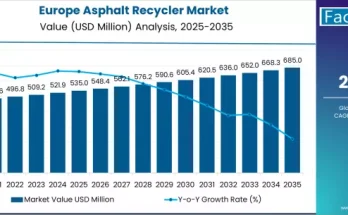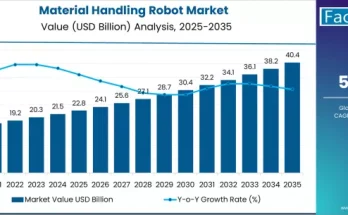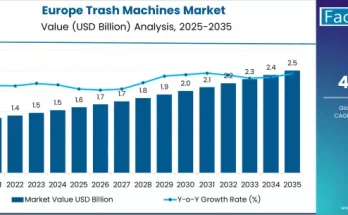The container handling equipment market is rapidly evolving as global trade volumes expand and port operations modernize. Container handling equipment, including reach stackers, forklifts, straddle carriers, and automated guided vehicles (AGVs), is critical for efficient cargo movement, storage, and transportation in ports, warehouses, and industrial logistics hubs.
With the increasing emphasis on faster cargo operations, reduced turnaround times, and automation, container handling equipment has become essential for shipping companies, port authorities, and logistics operators. The market growth is driven by the need for reliable, high-capacity machinery that supports safe and streamlined operations.
Market Overview
Container handling equipment is designed to lift, transport, and stack containers safely and efficiently. These machines are engineered to manage heavy loads, optimize operational workflows, and improve throughput in terminal yards and logistics centers.
Technological advancements, such as automation, telematics, and electric-powered machinery, are transforming traditional handling operations. Modern equipment allows operators to monitor performance, manage maintenance schedules, and optimize container movements in real time.
Manufacturers are focusing on durable, versatile, and high-capacity machines capable of handling containers of varying sizes and weights. Energy-efficient designs, low-emission engines, and eco-friendly components are increasingly incorporated to comply with global environmental standards and reduce operational costs.
The market is also shaped by the rise of smart logistics systems that integrate container handling equipment with digital management platforms. These systems allow real-time tracking, predictive maintenance, and resource optimization, ensuring seamless operations in increasingly complex supply chains.
Regional Insights
North America
North America remains a leading market due to its extensive port infrastructure, advanced logistics networks, and high demand for operational efficiency. The adoption of automated, electric, and hybrid container handling equipment is rising to meet sustainability goals and reduce operating costs.
Europe
Europe emphasizes environmentally friendly and energy-efficient equipment in line with strict regulations. Ports and terminals are integrating automation and predictive maintenance tools to improve safety and operational performance, driving demand for advanced container handling machinery.
Asia-Pacific
Asia-Pacific is a high-growth region for container handling equipment due to increasing trade volumes, expanding industrial sectors, and investments in port modernization. Countries like China, India, and Japan are adopting advanced machinery to enhance throughput, reduce congestion, and support growing e-commerce and manufacturing sectors.
Rest of the World
Latin America, the Middle East, and Africa are gradually modernizing port infrastructure and logistics networks. Rising industrialization and international trade are fueling demand for mechanized container handling equipment to optimize cargo operations and improve productivity.
Key Trends & Forecast
- Automation and Smart Operations
The integration of AGVs, telematics, and IoT-enabled equipment allows terminals to automate container movements, monitor performance, and schedule maintenance proactively, reducing downtime and operational errors. - Electric and Hybrid Equipment Adoption
Environmentally friendly machinery with low emissions is increasingly preferred to meet sustainability and regulatory standards. Electric and hybrid container handling equipment reduces fuel consumption and operational costs while maintaining performance. - High-Capacity and Versatile Equipment
Multi-purpose handlers capable of lifting containers of various sizes and weights enhance operational flexibility. High-capacity machines improve terminal throughput and reduce bottlenecks in busy ports and warehouses. - Data-Driven Performance Monitoring
IoT, sensors, and telematics enable real-time tracking of equipment utilization, fuel consumption, and predictive maintenance. Data-driven insights help operators optimize workflows and extend equipment lifespan. - Focus on Safety and Efficiency
Ergonomic designs, operator assistance systems, and anti-collision technologies improve safety while increasing operational efficiency. These features are critical for high-traffic port and warehouse environments.
Applications & End-Use Outlook
Container handling equipment serves a wide range of applications across logistics, transportation, and industrial sectors:
- Ports and Terminals: Equipment such as reach stackers and straddle carriers enable stacking, loading, and unloading containers efficiently, reducing turnaround time.
- Shipping Companies: Machinery facilitates smooth cargo handling, supporting fast delivery cycles and reducing operational bottlenecks.
- Industrial and Manufacturing Hubs: Forklifts and handlers optimize internal container movement, ensuring consistent production flow and storage efficiency.
- Intermodal Freight Terminals: Equipment supports seamless transfer of containers between road, rail, and sea, enhancing supply chain efficiency.
- Warehousing and Distribution Centers: Automated and high-capacity handlers improve storage density, minimize handling errors, and support e-commerce fulfillment operations.
The growing adoption of smart management and monitoring systems enhances visibility, safety, and operational productivity across all end-use segments.
Challenges and Opportunities
The container handling equipment market faces challenges such as high initial investment, maintenance complexity, and the need for skilled operators. Market growth is also influenced by fluctuations in trade volumes and infrastructure development cycles.
However, opportunities are significant. Emerging technologies such as autonomous vehicles, electric machinery, and predictive maintenance platforms are improving reliability and operational efficiency. Expanding trade activities, port expansion projects, and e-commerce growth present substantial opportunities for manufacturers. Collaborative initiatives between equipment providers, logistics companies, and terminal operators are accelerating technology adoption and expanding market reach.
Conclusion
The container handling equipment market is essential for modern logistics, port operations, and industrial cargo management. As global trade and e-commerce continue to expand, the demand for high-capacity, automated, and eco-friendly container handling machinery is growing.
Integration of smart technologies, energy-efficient designs, and data-driven monitoring ensures that container handling equipment remains central to operational efficiency, safety, and sustainability. Investing in advanced machinery is critical for ports, logistics operators, and industrial players seeking to optimize container operations and maintain a competitive edge in a rapidly evolving global market.
Browse Full Report – https://www.factmr.com/report/4193/container-handling-equipment-market



